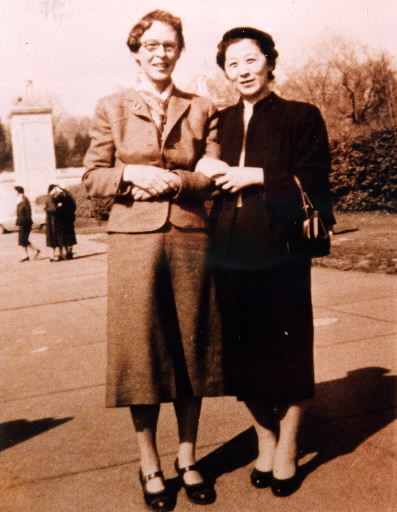Hiroshima Girls, Part 2: Bridging Japan and the United States [4]
Jul. 3, 2010
Two "mothers" share hardships and give love
by Masami Nishimoto, Staff Writer
This feature series on the "Hiroshima Girls," also known as "Hiroshima Maidens," is a close look at a number of Japanese women who were impacted by the atomic bombing of Hiroshima. The series was originally published in 1996.
After 40 years, one of the "Hiroshima Girls" still treasures a photo which shows a Japanese woman and an American woman smiling with their arms entwined. One of the doctors who treated the girls, Dr. Bernard Simon, 84, extolled their contribution, saying, "The project owes its success, in great measure, to those two ladies."
The "Hiroshima Girls" were in the United States for treatment for a period of a year and a half. The women in the photo are Hatsuko Yokoyama and Ida Day. Ms. Yokoyama, 87, is a resident of Nishi Ward, Hiroshima. She accompanied the 25 girls from Hiroshima and stayed close by as they underwent their surgeries. Ms. Day, who died three years ago at the age of 86, was director of the American Friends Service Committee (AFSC), a Quaker organization, and helped arrange the host family program.
The Quakers are a Protestant denomination which began in England in the mid-17th century. They do not maintain churches, and one of their beliefs is "How can human beings be killed, when God dwells within"? Even in times of war, the Quakers refuse to take up arms. The "Hiroshima Girls," in pairs, stayed with these peace-loving people.
The Quaker families became hosts upon the request of Ms. Day. The families shuttled the Japanese women back and forth to the hospital, took them to baseball games, and organized picnics, among other social activities. They provided them with opportunities to learn English conversation, typing, and dressmaking, hoping that such skills would enable the women to support themselves. One woman, a teacher, took a year's leave from work and hosted four girls, even though she was a widow.
All of them sought to allay the women's fears of facing surgery in an unfamiliar country. The women also became attached to their families and called their host parents "Papa" and "Mama." Despite the difficulties of communicating verbally, they developed ties akin to real parents and daughters.
Julia Kolkeback, 85, one of the few remaining host family members, told why she agreed to take part in the project: "We could care for people who were injured by a terrible weapon which burned everything to the ground. I felt honored to be given the opportunity."
Along with Quakers, Japanese-Americans also sympathized with the young women. During the war between the United States and Japan, Japanese-Americans were forced to endure extreme hardship when they were sent away to internment camps. A New York-based Japanese-language newspaper, the Hokubei Shimpo, carried articles on the support Japanese-Americans offered the "Hiroshima Girls."
One of the headlines read: "442nd Regimental Combat Team Invites Girls to Ball, Funds Raised." A ball was held by second-generation Japanese-Americans connected to an Asian-American army unit who were dispatched from internment camps to fight in Europe during World War II. At the same time, first-generation Japanese-Americans invited the women to their homes to cook Japanese food for them. This was at a time when they were all busy rebuilding their own lives.
Jimmy Konno, 73, a former member of the 442nd regiment, said, "It's only natural for us to help people in need. Instead, what really impressed me was the girls' courage to live through hardships." Mary Kouchiyama, 75, whose late husband was a member of the same regiment, commented from her home in the black neighborhood of Harlem, "We were angry that women and children were killed and wounded by a bomb which had never been used before."
Ms. Kouchiyama was busy raising four children at the time, and she said with a smile that she always made cookies for the women since Japanese food was not her forte. She added, "Helen was always tending to the girls in the hospital as if she were their mother. I wonder how she is these days."
Helen is Ms. Yokoyama's middle name. Though her health is poor now, she agreed to be interviewed, saying she wanted to convey this message: The women were given a lot of love from people such as Ms. Day, and this is why they could regain the courage and confidence to carry on in their lives.
Ms. Yokoyama was born in the United States and graduated from California State University. After the war, she worked for the Atomic Bomb Casualty Commission (ABCC) in Hiroshima. When she was asked to accompany the girls, she left her job without hesitation and also had to take leave of her husband and two children. "I had to do it," she said. She is one of those who gave love selflessly to the "Hiroshima Girls."
(Originally published on July 11, 1996)








